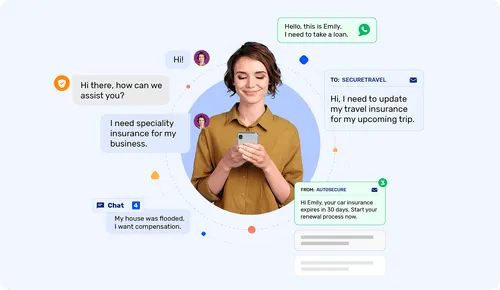The insurance industry, traditionally characterized by cumbersome paperwork and one-size-fits-all customer service approaches, is undergoing a significant transformation. The shift from static forms to dynamic interactions represents a pivotal evolution in how insurers collect and utilize customer data. This evolution is largely driven by the integration of sophisticated technologies like customer interaction engines, exemplified by platforms such as EasySend.
The era of paper forms
Traditionally, the insurance industry relied heavily on paper forms for all sorts of customer interactions, from application processes to claims and policy updates. Customers would often have to fill out lengthy, complex forms by hand, a process fraught with potential for errors and omissions.
- Prone to Errors: Handwritten forms are susceptible to misinterpretation and can lead to significant errors in data entry.
- Time-Consuming: The process of filling out, mailing, processing, and verifying paper forms can lead to lengthy delays.
- Resource Intensive: Handling, storing, and managing paper forms requires substantial physical space and administrative effort.
- Environmental Impact: The use of paper forms contributes to substantial paper waste, aligning poorly with environmental sustainability efforts.
The era of static forms
The initial digital shift moved away from paper to static electronic forms, which replicated the paper experience in a digital format. Although this was a step forward, static forms still presented limitations due to their inflexible nature. For decades, insurance companies relied heavily on static online forms and PDF documents to collect customer data. This method was not only time-consuming but often resulted in a frustrating customer experience due to the rigid, one-directional nature of the interactions. Customers were required to fill out lengthy forms, often providing the same information multiple times across different documents without any personalization or context-aware assistance.
- Error-Prone: Manual data entry is susceptible to errors, which can complicate claims processing and policy issuance.
- Inefficiency: The time-consuming process of filling out forms can lead to delays in service delivery.
- Poor Customer Experience: Lack of interaction and personalization can deter customers, affecting satisfaction and retention.
Transition to dynamic interactions
The introduction of customer interaction engines has revolutionized the data intake process in the insurance industry. These platforms enable what is now known as 'dynamic dialogues' — interactive, personalized communication flows that adapt to the customer’s responses in real-time.
- Enhanced Personalization: By integrating with backend systems, interaction engines like EasySend can pull relevant customer data to personalize the dialogue, making the process more intuitive and less repetitive.
- Increased Efficiency: Automation reduces the need for manual data entry, speeding up the entire data collection process and reducing human error.
- Improved Customer Engagement: Interactive and responsive interactions make the data intake process more engaging for customers, improving their overall experience.
The shift from traditional paper and static forms to dynamic customer interactions has revolutionized customer data intake in the insurance industry. Here are a few examples that illustrate how dynamic interactions are being implemented effectively in real-world scenarios:
Automated claims processing
- Company: A leading auto insurance provider
- Implementation: This company implemented a dynamic dialogue system for handling accident claims. The system prompts users through an interactive form on their mobile app, asking for specifics about the accident. Based on the user’s input, it dynamically adjusts the questions to gather the necessary details for the claim, such as the extent of damage and the exact circumstances of the accident.
- Impact: The introduction of this dynamic system reduced the average claim processing time by over 30% and significantly improved customer satisfaction rates.
Personalized policy renewals
- Company: A multinational life insurance company
- Implementation: Utilizing a dynamic dialogue platform, this insurer automated its policy renewal process. The system sends personalized reminders to customers with tailored messages based on their policy details and past interactions. It guides them through a step-by-step renewal process, which adjusts based on the options they select, such as changes in coverage or personal information.
- Impact: This approach has led to a higher renewal rate, with an increase in customer retention by 25%.

Onboarding new customers
- Company: A regional health insurance firm
- Implementation: For new customer onboarding, the firm uses a dynamic dialogue interface that integrates directly with their CRM system. New clients are guided through a digital onboarding process where the system asks personalized questions based on the initial data provided, such as age, medical history, and preferred coverage.
- Impact: This system not only streamlined the onboarding process by 40% but also ensured higher data accuracy and a more engaging experience for new clients.
Interactive policy adjustment
- Company: A property and casualty insurance provider
- Implementation: The insurer implemented a customer interaction engine to handle policy adjustments dynamically. Whenever customers need to update their policies, the system guides them through an interactive dialogue that adjusts based on the type of policy and specific customer needs, like adding new assets or changing coverage limits.
- Impact: This method has improved operational efficiency and customer satisfaction by providing quick and accurate policy adjustments tailored to individual needs.
These examples highlight how dynamic interactions not only enhance the efficiency of processes within insurance companies but also significantly improve the customer experience by providing personalized, engaging, and responsive interactions. This trend is set to grow as more insurers recognize the benefits of integrating advanced technologies to meet the needs of a digital-first customer base.
Looking ahead: the future of customer interactions in insurance
The shift from static forms to dynamic ustomer interactions is just the beginning. As technology continues to advance, we can expect even more sophisticated tools for customer interaction. Predictive analytics, AI, and machine learning will further refine the personalization of customer communications, making them even more context-aware and responsive to individual customer needs.
In conclusion, the evolution of customer data intake from static forms to dynamic interactions marks a significant leap forward for the insurance industry. By adopting platforms like EasySend, insurers can not only enhance efficiency and customer satisfaction but also gain a competitive edge in the rapidly changing digital landscape. This transformation is essential for insurers who wish to thrive in the digital age, offering a clear roadmap for others in the sector to follow.
EasySend has been at the forefront of this transformation by providing a no-code platform that transforms traditional forms into digital processes. This not only simplifies the creation and management of dynamic interactions but also integrates seamlessly with existing CRM and ERP systems, enhancing data accuracy and accessibility.
- Streamlined Onboarding: EasySend facilitates quick and efficient customer onboarding processes, enabling insurance companies to capture necessary information through interactive, two-way communications.
- Real-Time Updates: Any changes in the customer's status or information can be instantly updated, ensuring all data remains current and accurate.
- Compliance and Security: EasySend ensures that all interactions comply with industry regulations and standards, maintaining high levels of data security and customer privacy.





